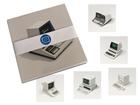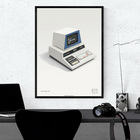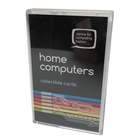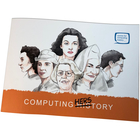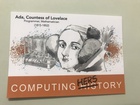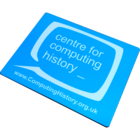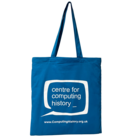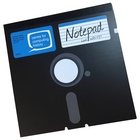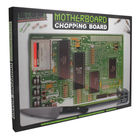
| Home > LEO Computers > LEOPEDIA > Other Memoirs, Reminiscences > Bill Forfar: Reminiscence |
Bill Forfar: Reminiscence
|
It all started when Wendy Craig woke me up with "A Cup of Tea and Lyons Tea Shops” ……
I was dozing on the settee when I became aware of LEO on the screen and Wendy Craig uttering the words Lyons Electronic Office. Acronyms, acronyms … they are a part of everyday life and the acronym LEO reminded me that in 1963 I chanced into the world of computing when my first job was as a Computer Operator for Shell Mex and BP on their new LEO 326 machines in Hemel Hempstead.
What an introduction, right at the cutting edge of the brave new world! 1024 words of 40 bit memory, made up of a matrix of magnetic rings each threaded on three wires which made it look rather like a thread-bare tapestry on a plastic frame about 12 inches square. You could SEE the bits in each WORD.
Sept 63…… Love, love me do
A wonderfully air-conditioned room with two LEO 326’s: each with 8 tape decks, 2 paper tape readers, a paper tape punch, card reader, card punch, two printers, main console and Engineer’s Control panel. The place was jammed by trolleys filled with the input for the jobs - mag tapes to read, some work tapes for the sorts, mag tapes for output into the next job and paper tape with daily sales tickets to be read by the Elliott Readers. This tape was punched from the handwritten dockets sent from the depots where the road tankers filled up with diesel or petrol.
I remember we had one operator on Mag Tapes, one on Peripherals, one on Buttons. The cry rang out - "Allocate mag tape on Channel 2 Route 2: Printer on 6/1: Paper Tape output on 7/1” The job started and the P/T began to fly through the reader into a large metal bin. Mag tapes inched forward, reports printed out, reel after reel of P/T filled the bin. Don’t lose the end – it’s all got to be rewound in case the job fails or the tape needs to be dibbed.
The jobs failed sometimes due to mis-punches in the P/T so out with the dibber and the black-tape to repunch a character or two. One day a reel stopped repeatedly just after a splice point, the data prep girls had joined two reels together. However the second tape had been turned over and joined upside down to the first one. The sprocket holes seemed to match but the 2-track side had been joined to the 3-track side and carefully trimmed to make a neat splice so it looked like the 5-track tape was supposed to look. Another day came the words – "I bet you can’t hit the big red EMERGENCY STOP on the Engineer’s panel from here with that reel of black and sticky”…. Zooom……Ooops……. Silence except for "You’ve won the prize, Jim!” Then the problem was how to doctor the console log to cover up the re-run time. July 64…. Please, please me
The task now was to learn Assembler, then CLEO for writing programmes. Wow, a step up the employment ladder. The DSR – Dealer Site Record -with filling station information covering the number of pumps, A-road or B-road, car dealership, gallonage for the storage tanks, throughput per week, location and so on. Did you know there are even waterside filling stations for barges? Then began my introduction to a look-up table to check the map reference was correct for the site. It was planned to use this to work out the best road route for the tanker from the depot to each filling station and back to the depot – this was leading edge use of computers and might save money. The edge of the whole country was set up in map references so garage could be mistakenly put in the sea somewhere! In fact this routing idea was too heavy on computing calculation and, anyway, the tanker drivers were the experts on minimising the road miles. Development deferred!
Oh, the elapsed time it took to get a compilation and test of the programme back from the machine! One turn round every three days only to find there was a simple coding error. There were too many programmers, too many mistakes and too much operational work for the hours in the day. But the LEOs proved their worth and Shell Mex BP’s profitability rose. Sep 65 … What’s new Pussycat?
I bade farewell to Hemel and enrolled on the Computer Science degree at Hatfield, which had 2 periods of 6 months working in a business during the 4-year course. But now the computer (I hesitate to use the word) was an Elliott 803B, all paper tape and not a mag tape to be seen. However it did have long-life plasticised paper tape from which to load the operating system! Output had to be via paper tape and then printed via a Teletype.
Still I learned a lot. At the start of year 2 it was back to Hemel for 6 months commercial experience working on another programme. All acronyms were related to the sales and delivery world of the oil industry in the UK. Then other languages, FORTRAN, COBOL, Algol and more needed to be mastered. Mar 1968 ….. Come on baby light my fire…..
…..I spent time somewhere else…. NO, not at Her Majesty’s Pleasure!
Aug 1969 ….. Zebedee time
English Electric LEO Marconi had lost the sales battle to Univac at the Shell site. The machines had changed to become Univac 1100’s with the FASTRAND storage device holding an infinite amount of information so you wouldn’t need to store information on mag tapes anymore….. wait a moment, what was that saying about systems expanding to fill the available storage? We were soon back using mag tapes and there were too many programmers developing too many programmes and too many operational programmes to run in the available time.
What goes round comes around, things don’t really change do they…..? Which brings me in a roundabout way to the time I witnessed Real Magic. The office block had a magnificent view of the junction where six roads met. A scaffold tower went u in the middle, six large white blobs appeared at the end of each road and many concentric circles were drawn. At five minutes to four o’clock the High Priest climbed the Tower holding a megaphone. Work stopped and our windows were crowded with baffled observers. His yellow-jacketed assistants hovered on the kerbs and at precisely 4pm they leapt into action to make a Magic Roundabout. Two lanes each way and six mini-roundabouts later it soon slowed the traffic to a crawl but after a few days the locals became accustomed to it and they zoomed round. In at road 1 go left to road 2 or 3, it’s quicker to go right to 5 and 6, but which way to road 4? … end of my Shell Mex BP involvement…. Creator : LEO This exhibit has a reference ID of CH53400. Please quote this reference ID in any communication with the Centre for Computing History. |
|


